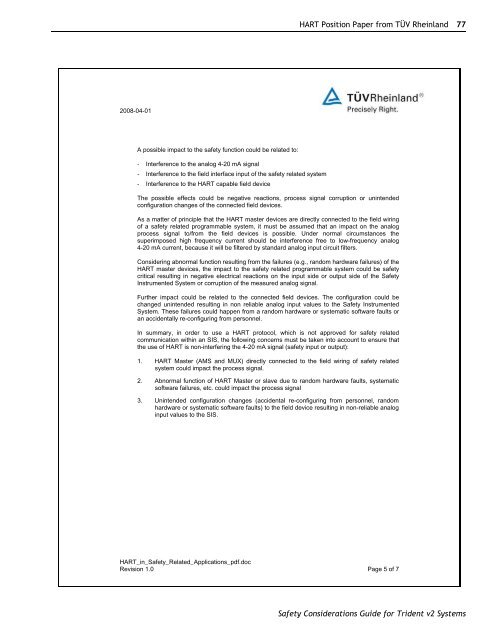Safety Considerations Guide for Trident v2 Systems - TUV ...
Safety Considerations Guide for Trident v2 Systems - TUV ...
Safety Considerations Guide for Trident v2 Systems - TUV ...
Create successful ePaper yourself
Turn your PDF publications into a flip-book with our unique Google optimized e-Paper software.
2008-04-01<br />
A possible impact to the safety function could be related to:<br />
- Interference to the analog 4-20 mA signal<br />
- Interference to the field interface input of the safety related system<br />
- Interference to the HART capable field device<br />
HART Position Paper from TÜV Rheinland 77<br />
The possible effects could be negative reactions, process signal corruption or unintended<br />
configuration changes of the connected field devices.<br />
As a matter of principle that the HART master devices are directly connected to the field wiring<br />
of a safety related programmable system, it must be assumed that an impact on the analog<br />
process signal to/from the field devices is possible. Under normal circumstances the<br />
superimposed high frequency current should be interference free to low-frequency analog<br />
4-20 mA current, because it will be filtered by standard analog input circuit filters.<br />
Considering abnormal function resulting from the failures (e.g., random hardware failures) of the<br />
HART master devices, the impact to the safety related programmable system could be safety<br />
critical resulting in negative electrical reactions on the input side or output side of the <strong>Safety</strong><br />
Instrumented System or corruption of the measured analog signal.<br />
Further impact could be related to the connected field devices. The configuration could be<br />
changed unintended resulting in non reliable analog input values to the <strong>Safety</strong> Instrumented<br />
System. These failures could happen from a random hardware or systematic software faults or<br />
an accidentally re-configuring from personnel.<br />
In summary, in order to use a HART protocol, which is not approved <strong>for</strong> safety related<br />
communication within an SIS, the following concerns must be taken into account to ensure that<br />
the use of HART is non-interfering the 4-20 mA signal (safety input or output):<br />
1. HART Master (AMS and MUX) directly connected to the field wiring of safety related<br />
system could impact the process signal.<br />
2. Abnormal function of HART Master or slave due to random hardware faults, systematic<br />
software failures, etc. could impact the process signal<br />
3. Unintended configuration changes (accidental re-configuring from personnel, random<br />
hardware or systematic software faults) to the field device resulting in non-reliable analog<br />
input values to the SIS.<br />
HART_in_<strong>Safety</strong>_Related_Applications_pdf.doc<br />
Revision 1.0 Page 5 of 7<br />
<strong>Safety</strong> <strong>Considerations</strong> <strong>Guide</strong> <strong>for</strong> <strong>Trident</strong> <strong>v2</strong> <strong>Systems</strong>
















